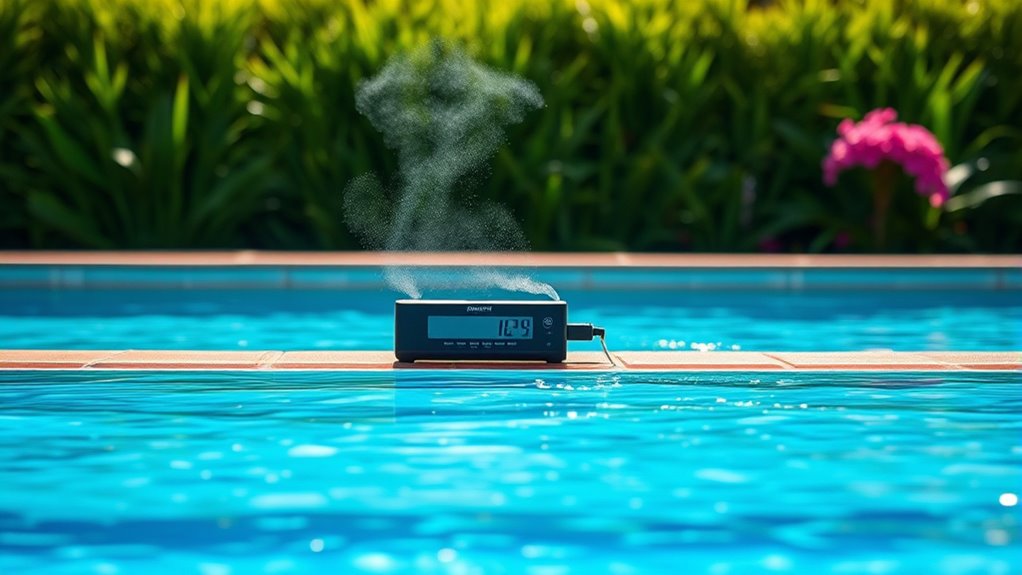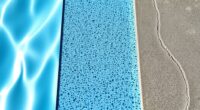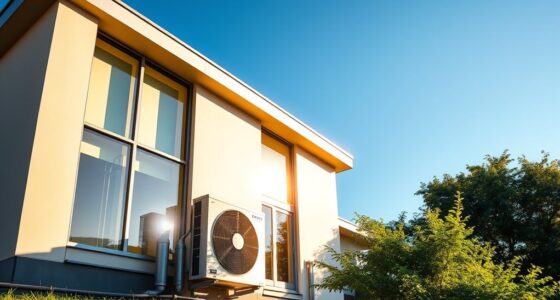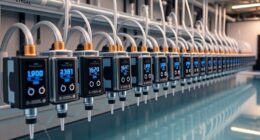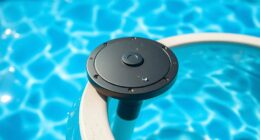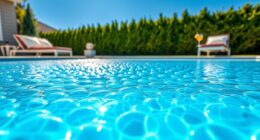To estimate your pool’s weekly water loss from evaporation, start by measuring the surface area and tracking daily water level changes with a ruler or measuring tape. Factors like temperature, humidity, and wind considerably influence evaporation rates. For example, hot, dry, and windy days increase water loss. By multiplying your pool’s surface area by your daily evaporation rate and then by seven, you get an approximate weekly loss. Keep exploring to learn how to refine these estimates and reduce water waste.
Key Takeaways
- Measure daily water level changes and multiply by the pool’s surface area to estimate weekly water loss.
- Use the conversion factor where 1 inch of evaporation over 1 sq ft equals approximately 0.623 gallons.
- Evaporation rates depend on environmental factors like temperature, humidity, and wind speed, which should be considered for accuracy.
- Employ evaporation calculators or formulas that incorporate local weather data for more precise estimates.
- Regular measurements over several days help distinguish evaporation from leaks or splash-out, refining weekly loss calculations.
Factors That Influence Pool Evaporation
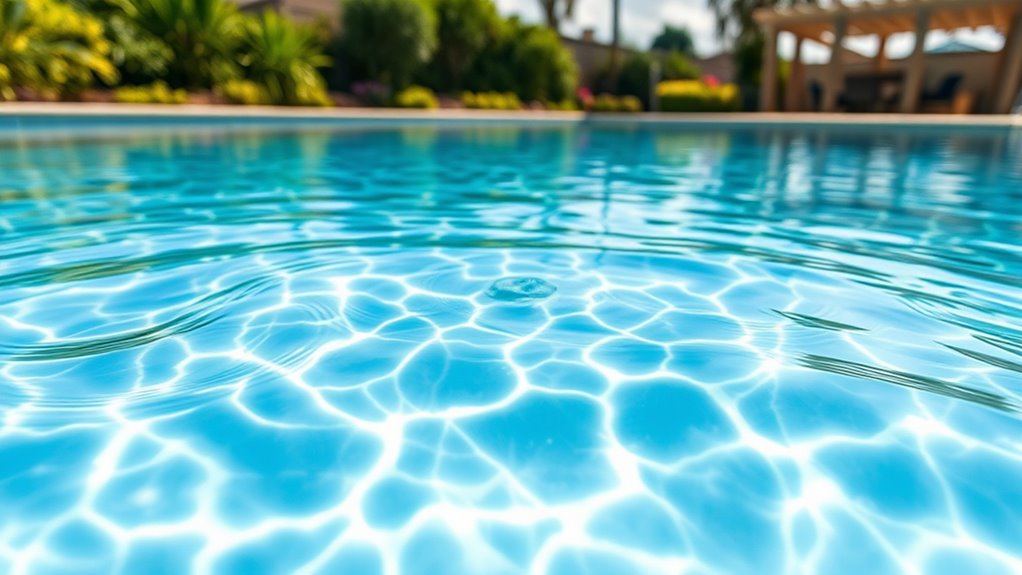
Several factors directly impact how quickly a pool evaporates. First, wind plays a significant role; stronger breezes remove water vapor from the surface faster, increasing evaporation. Sunlight boosts evaporation by heating the water, causing more molecules to escape into the air. Humidity levels matter too—drier air draws moisture away from the pool more efficiently than humid air. Additionally, the water temperature itself influences evaporation; warmer water evaporates faster. Pool covers can dramatically slow this process by trapping moisture and blocking wind. Though not as immediate, nearby vegetation and weather conditions can also affect evaporation rates over time. Understanding these factors helps you predict water loss and manage your pool more effectively.
Understanding the Surface Area and Temperature Impact
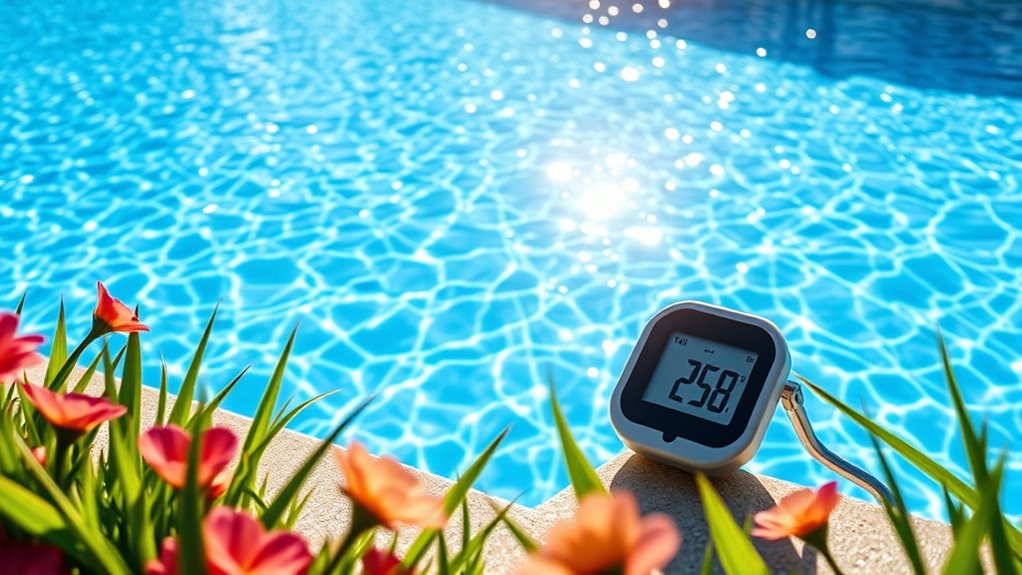
Your pool’s surface area directly impacts how much water evaporates, with larger surfaces losing more moisture. Temperature plays a key role, as higher temperatures increase evaporation rates considerably. By understanding how to calculate these effects, you can better estimate total water loss and manage it effectively. Additionally, factors such as consistent moisture levels influence evaporation rates, especially in outdoor settings.
Surface Area Significance
Have you ever wondered how the size of a surface influences evaporation? The larger the surface area of your pool, the more water can escape into the air. Think of it like a sheet of fabric; the bigger the sheet, the more its edges are exposed. With a bigger surface, evaporation rate increases because more water molecules are exposed to air, which accelerates the process. Additionally, high surface area can amplify the effects of environmental factors such as wind and temperature, further increasing water loss. Conversely, a smaller surface area means less water is lost each week. This is why a wide, shallow pool can lose more water than a narrow, deep one of the same volume. Understanding this helps you predict weekly water loss better and plan for refilling and maintenance. So, the size of your pool’s surface truly plays a pivotal role in how much water evaporates.
Temperature’s Effect on Loss
As temperature rises, evaporation speeds up because warmer air causes water molecules to move faster and escape more readily. When the temperature increases, the water’s surface energy intensifies, making it easier for molecules to break free into the air. This process markedly boosts water loss from your pool, especially during hot days. Cooler temperatures slow down evaporation because molecules have less energy to escape. Additionally, higher temperatures create a greater vapor pressure difference between the water surface and the air, facilitating faster evaporation. The headphone jack types used in devices can influence how you connect audio equipment, but understanding temperature effects helps you anticipate how much water your pool might lose during different weather conditions, so you can plan accordingly.
Calculating Evaporation Rate
Understanding how surface area and temperature influence evaporation rates is essential for accurate calculations. The larger your pool’s surface area, the more water can evaporate each day. To estimate weekly loss, measure the pool’s length and width, then multiply them to find the surface area in square feet or meters. Higher temperatures increase evaporation, so tracking local weather helps refine your estimate. Warmer days cause more water to turn into vapor, especially if the surface is exposed to direct sunlight. Remember, evaporation isn’t linear; hotter, sunnier days lead to faster water loss. Additionally, sound design techniques such as monitoring environmental factors can help you develop a reliable estimate of weekly evaporation, helping you plan for water top-offs and maintain your pool’s water level efficiently.
Calculating Daily Water Loss Due to Evaporation
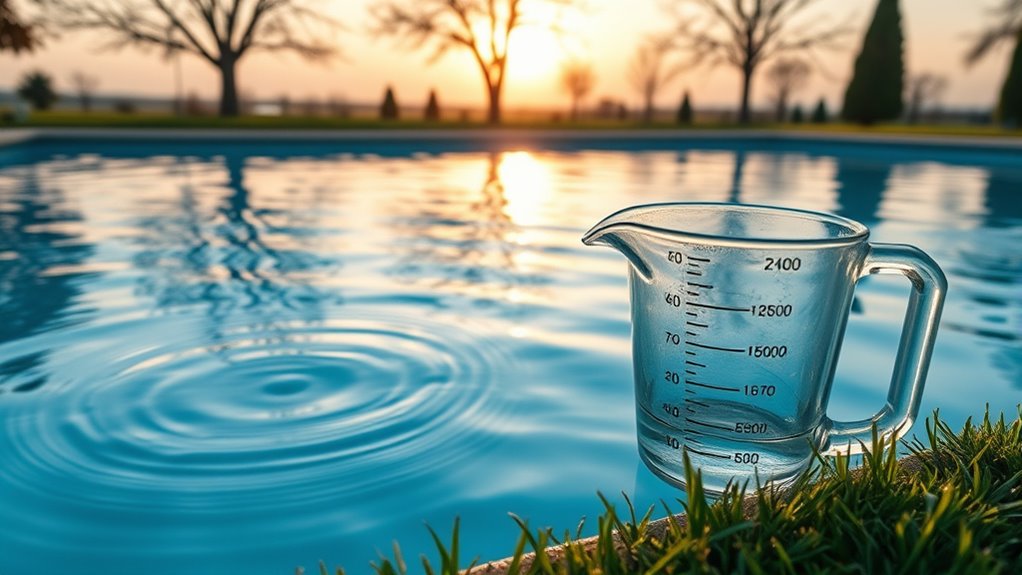
To calculate daily water loss from evaporation, you need to understand the factors that influence it, like temperature and surface area. Measuring how water levels change over time helps you track evaporation rates accurately. Once you have those measurements, you can estimate the total water lost each day. Incorporating tuning techniques used in Hyundai vehicles can serve as a helpful analogy for understanding how small adjustments can optimize overall performance—in this case, accurately estimating water loss.
Factors Influencing Evaporation
Several key factors directly influence how much water evaporates each day. Temperature plays a major role; higher temperatures increase evaporation rates by causing more water molecules to escape into the air. Humidity also matters—low humidity levels lead to faster evaporation because dry air pulls moisture away from the pool surface more effectively. Wind speed impacts evaporation by removing the thin layer of saturated air near the water’s surface, allowing more water to evaporate. Sunlight intensity boosts evaporation by heating the water, especially during peak sunlight hours. Additionally, the pool’s surface area affects the total water loss—the larger the surface, the more water can evaporate. Understanding these factors helps you estimate your pool’s weekly water loss more accurately.
Measuring Water Level Changes
Measuring how much water level changes in your pool provides a straightforward way to determine daily evaporation rates. To do this accurately, you need to observe the water line regularly. Imagine these key steps:
- Use a clean, straight object like a ruler or pool skimmer to measure from the pool’s edge to the water surface.
- Record the water level at the same time each day, preferably in the morning.
- Note any fluctuations, such as after a windy day or rain, which might affect readings.
- Subtract the current measurement from the previous day’s to find the change in water level.
Estimating Daily Loss
Estimating your daily water loss from evaporation involves converting the measured water level change into a volume. First, determine how much the water level drops each day. Then, use your pool’s surface area to calculate the volume loss by multiplying the area by the water level decrease in inches or centimeters. For example, if your pool is 15,000 gallons and the water level drops 0.25 inches daily, convert that height to a volume using your pool’s surface area. This gives you a precise estimate of daily water loss. Keep in mind, consistent measurements are key. Tracking these changes daily helps you identify patterns and evaluate if evaporation is your main water loss source, guiding your maintenance and refill strategies more effectively. Understanding the impact of evaporation math can help you better manage your water levels and prevent unnecessary refills.
The Role of Wind and Humidity in Water Loss

Wind and humidity substantially influence how quickly water evaporates from surfaces. When wind blows across your pool, it strips away the thin layer of saturated air above the water, speeding up evaporation. Low humidity levels mean the air can hold more moisture, encouraging water to vaporize faster. Conversely, high humidity slows this process because the air is already moist, reducing evaporation rate. To imagine this:
- Strong gusts whipping across the water’s surface.
- A dry, breezy day with humidity below 40%.
- Calm conditions with high humidity hanging in the air.
- Rapid evaporation during windy, arid afternoons.
These factors work together, accelerating or slowing water loss depending on the conditions, making wind and humidity critical in understanding your pool’s weekly water loss. Environmental factors like wind and humidity play a crucial role in determining the precise rate of evaporation.
Estimating Weekly Evaporation Rates
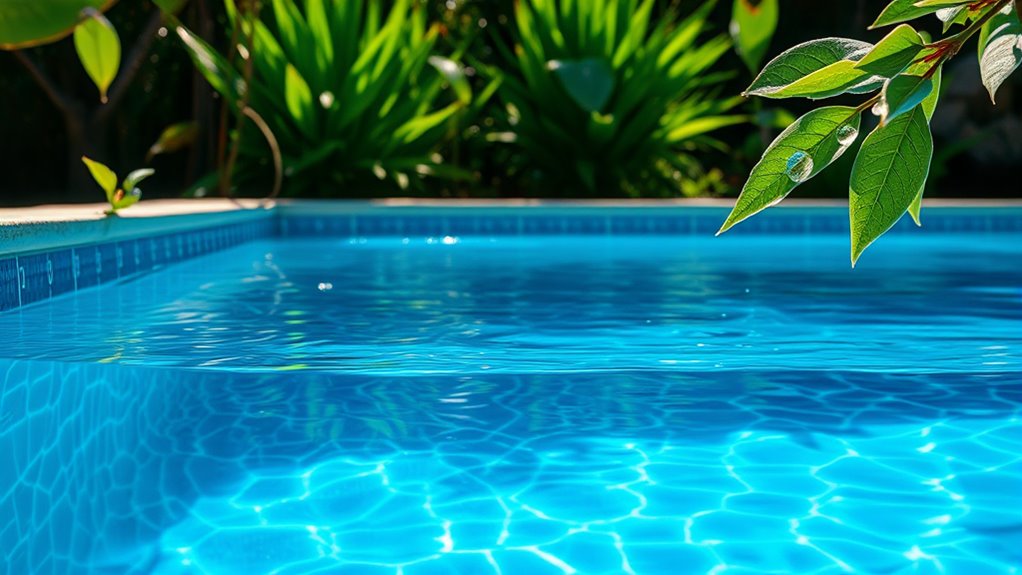
Have you ever wondered how much water your pool loses each week? To estimate this, start by measuring your pool’s surface area in square feet. Next, note the average daily temperature and humidity levels, as these influence evaporation. A common method is to use an evaporation rate formula: multiply the surface area by a rate in inches per day, which varies based on weather conditions. For example, in hot, dry weather, evaporation might reach 0.25 inches daily. Multiply that by seven to find weekly loss in inches, then convert to gallons (since 1 inch of water over 1 square foot equals roughly 0.623 gallons). This gives you a practical estimate of weekly water loss, helping you understand your pool’s evaporation pattern. Utilizing industry trends can further improve your understanding of evaporation factors.
Practical Tips to Minimize Water Loss

To effectively reduce water loss from your pool, implementing practical strategies can make a significant difference. First, cover your pool with a quality pool cover when not in use. This creates a barrier against evaporation and debris. Second, maintain proper water levels—keeping the water just below the skimmer ensures less surface area exposure. Third, control the wind around your pool by planting shrubs or installing windbreaks, which reduces air circulation that accelerates evaporation. Fourth, run your pool filter during cooler parts of the day, like early mornings or late evenings, to minimize water loss caused by heat and wind. Additionally, choosing the right pool equipment can help optimize water conservation. By adopting these simple steps, you can conserve water, save money, and keep your pool cleaner and more enjoyable.
Tools and Formulas for Accurate Measurement
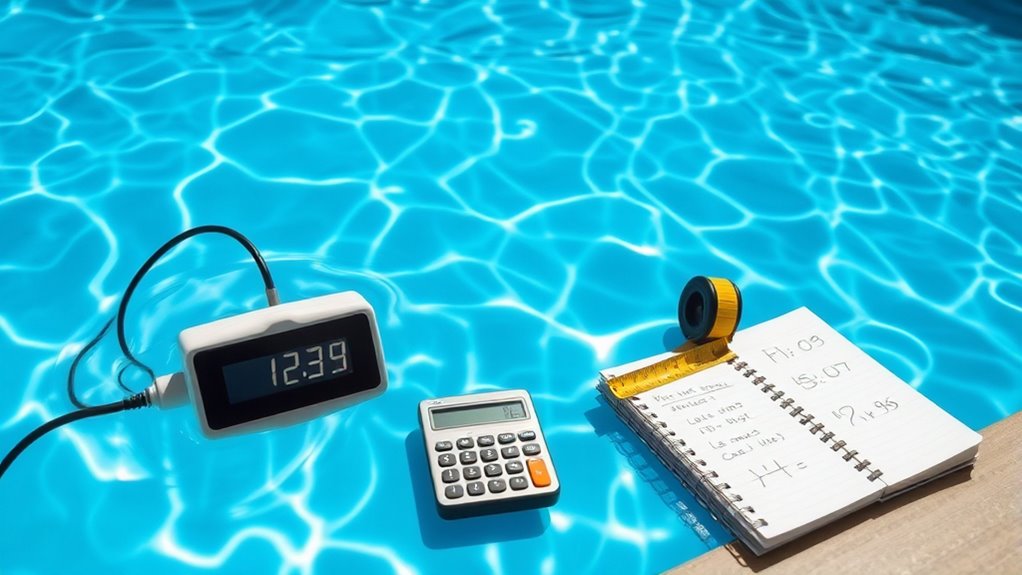
Accurate measurement of water loss requires the right tools and formulas to guarantee your estimates are reliable. You’ll need a reliable measuring container, like a marked bucket, to record water levels accurately. Use a ruler or measuring tape to measure the water height in the pool or bucket precisely. To calculate evaporation, employ formulas such as the volume change over time or the pool’s surface area multiplied by the water loss rate. A stopwatch helps track time intervals, ensuring measurements are consistent. Some pool owners use evaporation calculators or apps that incorporate weather data for more precise estimates. Incorporating HEPA filtration and other air quality technologies can also help improve indoor air conditions during pool maintenance or renovations. Combining these tools with simple formulas allows you to determine weekly water loss accurately, helping you identify whether evaporation or other issues are responsible for water level drops.
Interpreting Your Pool’s Water Level Changes
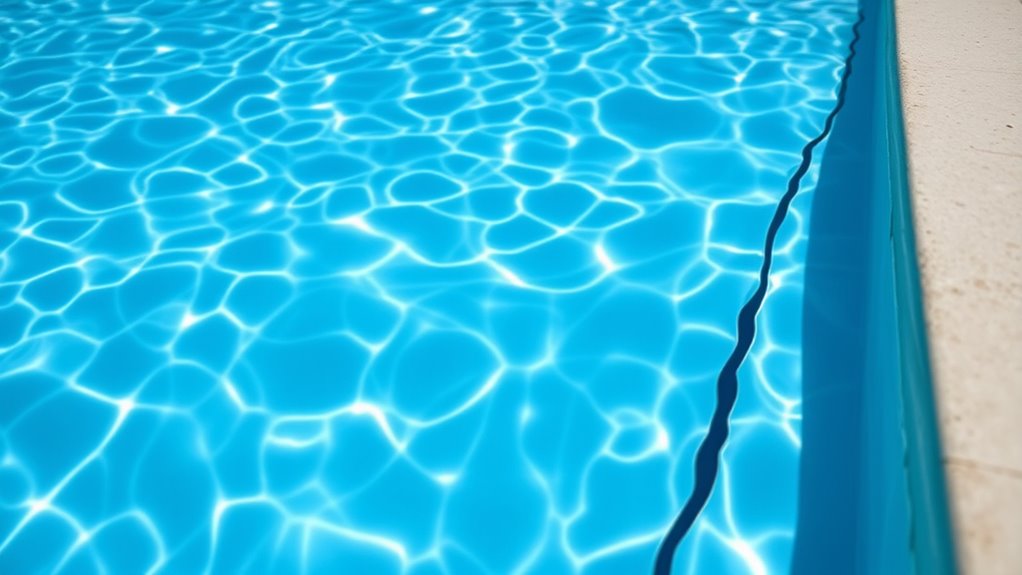
Monitoring your pool’s water level changes provides valuable insights into what’s causing water loss. When you notice the water drops consistently, it might indicate evaporation, leaks, or splash-out. To interpret these changes, consider these clues:
- Gradual decline over days suggests evaporation, especially during hot, dry weather.
- Sudden drops after storms or heavy rain could point to leaks or overflow.
- Consistent water loss despite topping off hints at leaks or evaporation under specific conditions.
- Water level fluctuations with temperature changes indicate evaporation, as warmer air increases water loss.
Frequently Asked Questions
How Does Evaporation Compare to Other Water Loss Sources Like Leaks?
Evaporation is usually the biggest water loss source for your pool, often accounting for most weekly water decrease. Leaks, on the other hand, tend to cause more abrupt and noticeable drops. If your water level drops steadily and gradually, evaporation is likely the culprit. But if you see sudden, significant drops or consistent low levels despite topping off, leaks are probably involved. Regularly inspecting your pool helps identify the main cause.
Can Water Chemistry Affect Evaporation Rates in Pools?
Like a mirror reflecting the sun’s glow, water chemistry influences your pool’s evaporation rate. When your pH, alkalinity, or salinity levels are off, it can make water evaporate faster or slower. Properly balanced chemicals create a stable environment, reducing unnecessary loss. Think of it as tuning a musical instrument—keeping everything in harmony guarantees your pool retains water longer, saving you time and money on refilling.
How Often Should I Check My Pool’s Water Level for Accuracy?
You should check your pool’s water level at least once a week to make certain it’s accurate. Regular checks help you catch evaporation or leaks early, preventing issues like corrosion or algae growth. After refilling, mark the water level with a stick or tape, so you can easily spot changes over time. Consistent monitoring keeps your pool balanced, saves water, and reduces maintenance costs.
Do Different Pool Types Evaporate Water at Different Rates?
Like a whispering breeze shaping the surface of a lake, different pool types influence evaporation rates. In-ground pools tend to lose water more slowly than above-ground ones, thanks to their insulation and surrounding soil. Vinyl-lined pools may evaporate faster because of their material, while concrete pools often retain more moisture. Temperature, humidity, and wind also play roles, but the pool’s construction type subtly dictates how quickly water vanishes into the air.
Is There a Seasonal Pattern to Weekly Water Loss?
Yes, there’s definitely a seasonal pattern to your weekly water loss. During warmer months, especially summer, your pool loses more water due to increased evaporation caused by higher temperatures, stronger sunlight, and often lower humidity. Conversely, in cooler seasons, water loss slows down. Windy days also boost evaporation rates regardless of the season. Monitoring these patterns helps you better manage water levels and prevent unexpected shortages.
Conclusion
By understanding the subtle dance between your pool’s surface, temperature, and the whispering wind, you become a master of its invisible currents. With careful measurement and mindful adjustments, you can tame the silent thief that steals your water, turning evaporation from an unpredictable foe into a manageable rhythm. Think of it as choreographing a delicate ballet—each step bringing you closer to a pool that stays lush and inviting, no matter what the weather whispers.
